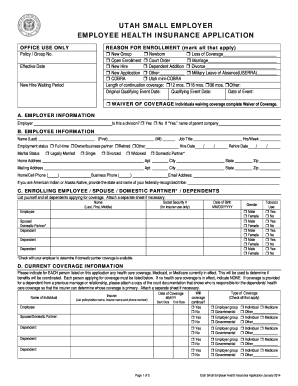Fill and Sign the Utah Health Insurance Application 2014 2019 Form

Valuable advice on preparing your ‘Utah Health Insurance Application 2014 2019 Form’ online
Are you fed up with the inconvenience of handling paperwork? Look no further than airSlate SignNow, the premier digital signature platform for individuals and organizations. Bid farewell to the monotonous routine of printing and scanning documents. With airSlate SignNow, you can effortlessly fill out and sign paperwork online. Utilize the powerful features embedded in this user-friendly and cost-effective platform to transform your paperwork management strategy. Whether you need to authorize forms or collect signatures, airSlate SignNow manages it all seamlessly, with just a few clicks.
Follow this comprehensive guide:
- Access your account or sign up for a free trial with our service.
- Click +Create to upload a document from your device, cloud storage, or our form library.
- Open your ‘Utah Health Insurance Application 2014 2019 Form’ in the editor.
- Click Me (Fill Out Now) to complete the form on your end.
- Add and designate fillable fields for others (if necessary).
- Proceed with the Send Invite settings to request eSignatures from others.
- Download, print your copy, or convert it into a reusable template.
Don’t fret if you need to collaborate with your colleagues on your Utah Health Insurance Application 2014 2019 Form or send it for notarization—our platform provides everything you require to accomplish such tasks. Establish an account with airSlate SignNow today and elevate your document management to a new height!
FAQs
-
What is the Utah Small Employer Employee Health Insurance Application?
The Utah Small Employer Employee Health Insurance Application is a streamlined process designed for small businesses in Utah to apply for health insurance coverage for their employees. It simplifies the documentation needed to ensure your team can access quality healthcare options tailored to small employers.
-
How does airSlate SignNow facilitate the Utah Small Employer Employee Health Insurance Application process?
airSlate SignNow empowers businesses to efficiently send and eSign the Utah Small Employer Employee Health Insurance Application, making the process quick and hassle-free. With our easy-to-use platform, you can manage all necessary documents in one place, ensuring compliance and reducing paperwork.
-
What are the pricing options for using airSlate SignNow for the Utah Small Employer Employee Health Insurance Application?
airSlate SignNow offers flexible pricing plans that cater to different business sizes and needs when completing the Utah Small Employer Employee Health Insurance Application. Our cost-effective solutions ensure that you can manage your health insurance documentation without breaking the bank.
-
What features does airSlate SignNow offer for managing the Utah Small Employer Employee Health Insurance Application?
airSlate SignNow includes features such as customizable templates, real-time tracking, and secure eSigning, specifically designed to streamline the Utah Small Employer Employee Health Insurance Application process. These tools enhance efficiency, saving you time and reducing administrative burdens.
-
Can I integrate airSlate SignNow with other software for the Utah Small Employer Employee Health Insurance Application?
Yes, airSlate SignNow easily integrates with various business tools and software, allowing for a seamless experience when completing the Utah Small Employer Employee Health Insurance Application. Integrations with platforms like CRM systems help you manage your documentation efficiently.
-
What are the benefits of using airSlate SignNow for the Utah Small Employer Employee Health Insurance Application?
Using airSlate SignNow for the Utah Small Employer Employee Health Insurance Application offers numerous benefits, including improved efficiency, reduced turnaround times, and enhanced security for your sensitive data. Our platform helps you stay organized and compliant while ensuring your employees' health insurance needs are met.
-
Is airSlate SignNow secure for handling the Utah Small Employer Employee Health Insurance Application?
Absolutely! airSlate SignNow takes security seriously, utilizing industry-standard encryption to protect your information during the Utah Small Employer Employee Health Insurance Application process. You can trust that your sensitive data is safe and secure with us.
Related searches to utah health insurance application 2014 2019 form
Find out other utah health insurance application 2014 2019 form
- Close deals faster
- Improve productivity
- Delight customers
- Increase revenue
- Save time & money
- Reduce payment cycles

